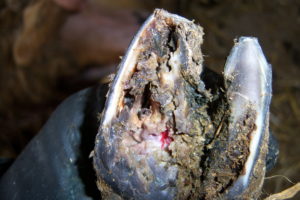How Much Does Footrot Cost?
18 October 2017 Research indicates the following production penalties due to footrot and other conditions.
Research indicates the following production penalties due to footrot and other conditions.
Footrot
Reduction in lamb growth rate 1.5 – 7.5%
Worms
Reduction in lamb growth rate 5 – 25%
Scab
Reduction in lamb growth rate 50%
Meadi Visna
Reduction in lamb growth rate 10%
Relative to some diseases footrot is minor, but individual farm circumstances matter. Lamb output has been estimated to be reduced by around 18% due to footrot in some studies. Anecdotal evidence suggests for each foot affected suckling lambs lose around 50 g per day against a target of 300g/day (around 15% weight loss per foot affected).
All estimates of disease costs are just that – estimates. So use these values with caution.
Lambs or ewes with footrot eventually recover and the target weight is regained, but if a marketing opportunity is missed on a group basis financial losses can be severe. Be very quick to run lambs through a formalin footbath at the first signs of scald as this may prevent it developing into footrot.
Similarly footrot can have much greater financial consequences for ewes if it is at a critical time. Affected ewes under pressure to get food prior to lambing may go down with pregnancy toxaemia, resulting in the loss of the ewe, her lambs and a disposal bill.
- Check the incidence of footrot in the flock, if it is over 2% it is an issue.
- Vaccination not only provides protection but reduces the incidence of footrot.
- If retaining your own replacements, you may prefer not vaccinate but to cull hard any lambs needing repeated footrot treatment.
- Tackle the problem well before key events – lamb sales, away wintering, ewe mating and lambing.
- Isolate infected sheep and treat.
- Footrot is a heritable trait; resistant sheep are less affected, buy them or breed them.
In conclusion footrot is a very expensive condition if it is allowed to progress. Consider vaccination if your current control programme is not being fully effective. On many farms continuous wet weather has meant this problem may have got out of hand and sheep need extra help.
John Vipond
Sign up to the FAS newsletter
Receive updates on news, events and publications from Scotland’s Farm Advisory Service
